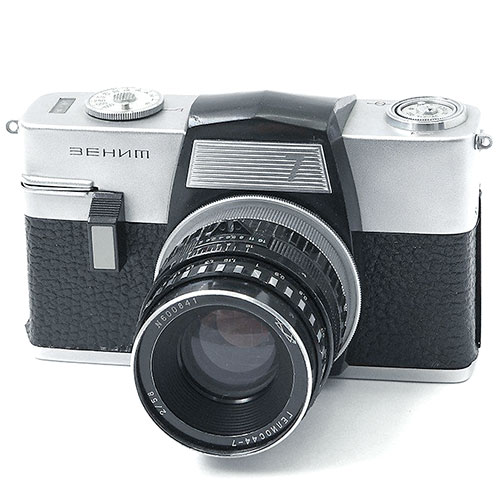Zorki-11
The Zorki-11 camera is one of the first Soviet cameras to have a fully automatic mode. Produced at the KMZ plant from 1964 to 1967.

Zorki-11 is the first Soviet automatic scale-focus camera. This Soviet rangefinder was a complete analogue of the Zorki-10 camera, only without a rangefinder.
Zorki-11 Specifications
- Type: 35mm scale-focus camera
- Manufacturer: KMZ plant
- Production period: from 1964 to 1967
- Format: 24x36cm on 135 film
- Lens mount: fixed lens
- Lens: Industar-63 f2.8/45
- Shutter: leaf shutter with speeds from 1/30 to 1/250 sec.
- Viewfinder: optical parallax viewfinder
- Lighmeter: selenium light meter
- Flash synchronisation: sync socket “X”
- Selftimer: mechanical
- Weight: 750 grams

As is the case with most other Soviet cameras, this device is not a purely Soviet invention. The Zorki-11 camera is essentially a clone of the Japanese Ricoh Auto 35 camera.
As mentioned above, the Zorki-10 and -11 are almost identical, with the exception that the rangefinder is missing in the 11th model. This, of course, is done to reduce the cost of the 11th model.

As we said before, the Zorki-10 and -11 cameras are among the first Soviet fully automatic cameras. For the 60s of the Soviet Union, this is a very big achievement.
Later, a lot of automatic film cameras appeared in the USSR, such as Vilia-Auto, FED-Mikron, etc. But automatic cameras from KMZ were ahead of devices from other Soviet factories.

The Zorki-11 camera was equipped with an Industar-63 f2.8/45 lens. This lens is part of the Industar lens family. These Soviet lenses are distinguished by their sharpness and smooth bokeh.
As with all leaf shutter cameras, almost all controls such as focus, shutter, ISO, etc. are concentrated around the lens. But unlike most other similar cameras, all these elements are located not at the top of the lens barrel, but at the bottom.

Like the more advanced model, Zorki-11 was equipped with a shutter with shutter speeds from 1/30 to 1/250 sec. This is an extremely small set of shutter speeds, even by the standards of a simple scale-focus camera.
For example, on older, and much simpler Smena cameras, a shutter was set where the slowest shutter speed was 1/15 sec. In our opinion, it was possible to install a shutter with a larger set of shutter speeds on a device that was positioned as an advanced camera.

All of the camera’s automatics are powered by a selenium light meter, which means that although the camera is fully automatic, it does not require batteries.
On the one hand, the presence of a selenium light meter is a big advantage, because the camera does not require batteries, but on the other hand, this is a disadvantage, because selenium is gradually losing its properties, and nowadays you can hardly find a Zorki-11 that works out shutter speeds correctly.

Conclusion
What can be said about the Zorki-11 Soviet film camera?
As is the case with most Soviet cameras, this model seems to us more of a collector’s item than a device with which you can take real photos in our time.
This camera does not have a rangefinder, the selenium light meter most likely does not work nowadays, the set of shutter speeds is too poor, and the controls are located in too inconvenient places.
By spending the same amount of money, you can buy other, much more convenient Soviet cameras. But if you want to buy the most unusual Soviet film camera, then Zorki-11 was created especially for you.







